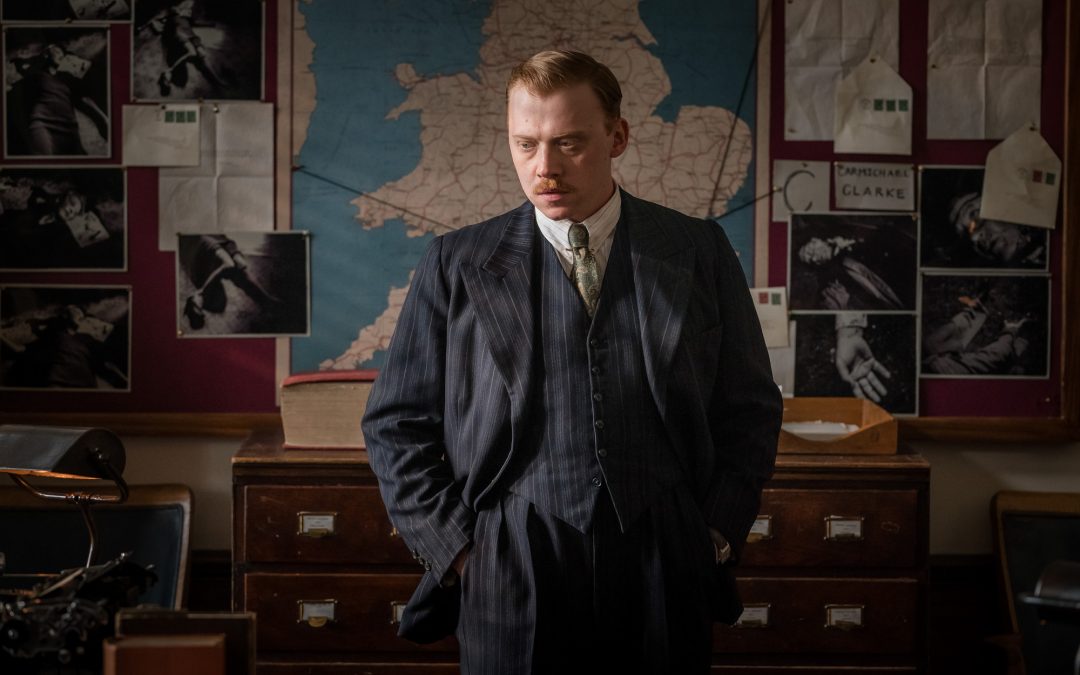This review contains spoilers.
“I’ve lived a long life,” says Hercule Poirot, with a weary drawl, during episode two of The ABC Murders.
It’s very easy to believe him. Starting with a flashback that shows us Poirot as a younger man arriving in England, fleeing from the Nazis and wondering just what to tell the officials in order to persuade them that he should be allowed to stay, and then moving through time to the old detective who rages that cruelty still exists in the world and he has not learned how to stop it, this is a Poirot who has kept as many secrets as he’s solved. And now it turns out that all the victims have their own connections to Poirot, and he must look back through his past to try to work out who will be killed next. It’s a game, not unlike the murder parties that he engineered in order to entertain the aristocracy, and his sense of shame that anyone should treat human life so cheaply – including himself, back in the day – infuses this adaptation.
The ABC Murderer, who we now know is one Alexander Bonaparte Cust, experiences shame, too; he feels it keenly. We don’t spend a lot of time with him, but Eamon Farren’s performance is so powerful and the writing so strong that Cust feels fully fleshed out. We never get close to seeing him commit a murder. Instead we watch him eat an unappetising breakfast and throw it up afterwards, or obsess about the boil on the back of a man’s head. When Cust asks the landlady’s daughter to stand on his bare back and draw blood, it’s a disturbing moment.
And, of course, the daughter wears bright red shoes, because this adaptation is all about red and yellow, using their appearance to signal danger in an otherwise washed-out England. Director Alex Gabassi builds on the colour scheme he put in place in episode one, and comes up with some stunning moments. At one point Poirot rushed to a telephone box to try to alert his old acquaintance, Sir Carmichael Clarke, to an attack upon his life. But his call was too late, and in that instant of realisation the camera framed Poirot within the bright red telephone box on the street, a lonely and dejected shape.
With Carmichael Clarke’s death comes the opportunity to see Poirot in a more familiar mode. His anger and fear is shelved while he collects the relatives and friends together in a drawing room and asks them questions, soaking up their evasive answers, and the master detective is still just as entertaining as ever. There remains something so satisfying about those interactions but leaving us waiting for them makes them hugely rewarding when they do occur. It’s not only a case of watching everyone’s smallest movements to see if we can also tell who is lying, but using the information we’ve already built up about them – and about Poirot himself – to appreciate the scene even more.
Moving on from the upper-class shenanigans of the letter C brings us to the next victim, one Dexter Dooley of Doncaster, and a hint of the ridiculous creeps in. Dooley (played by Gregor Fisher) is a ventriloquist with an extremely creepy dummy, and there’s some funny business in which the eye of the dummy is glued down only to slowly open as the murder is committed. A point-of-view shot from the dummy’s perspective is an odd choice here, followed soon after by Poirot warning of a ‘storm of slaughter’ (this adaptation is all about alliteration) and the imagining the face of a man covered in blood, looming from the dark window of an underground train. These touches are unnecessary when the script and performances are already doing a great job of creating and sustaining tension; hopefully the third and final episode won’t concentrating on using showier techniques when all this story needs is a continuation of that quiet, mounting dread.
Well, perhaps that’s not all it needs. Although the mysteries held by both the detective and the murderer are fascinating, the glue keeping me firmly stuck to the adaptation has been the relationship between Poirot and Inspector Crome (played by Rupert Grint). The two of them finally started reluctantly working together over a glass of brandy, and Crome began to appreciate the methods of the great detective. Grudging respect appears to be forming, although the question of who Poirot was when he arrived as a refugee – raised in episode one by Crome – has yet to be answered. Crome’s character is a very interesting one; I’m not sure that I want him to become Poirot’s ally as much as see him learn to be a better detective himself. His attempts at deduction so far have fallen far short, and Grint plays the character as being painfully aware of his own shortcomings in this area, which is both enjoyable and a bit uncomfortable to watch.
But for now, with one more episode to go, the burning question now must be how far along the alphabet Cust will manage to get before he’s caught – and whether those little hints of surprise awaiting us will pay off. For instance, Poirot’s inkling that the letters he received were written by a woman suggests that a twist might well be in this tale.
Forgive the alliteration there; I think it’s catching, and it’s difficult not to see once you’ve noticed it. The danger is that all these colours and tricks will overpower the story itself. But I’m guessing that if we stick with Cust, Crome and Poirot to the finish line, these strong performances should see us right to journey’s end.
Read Aliya’s review of the previous episode here.

